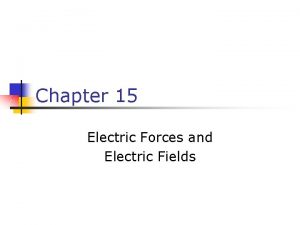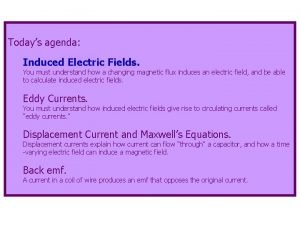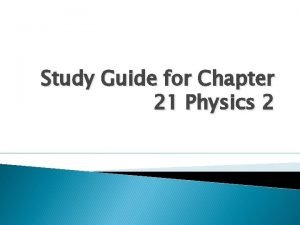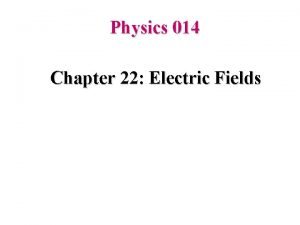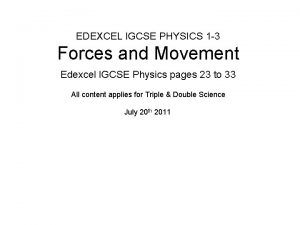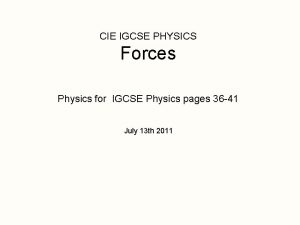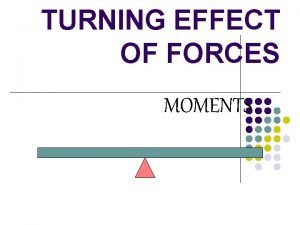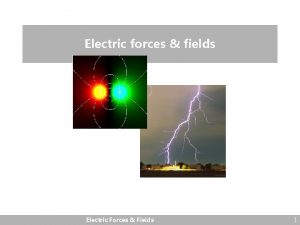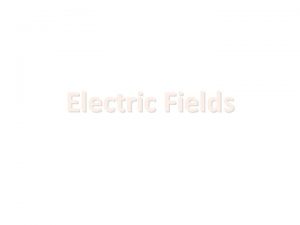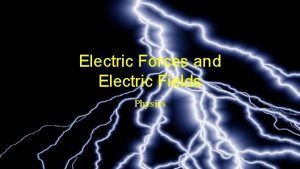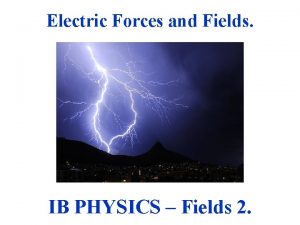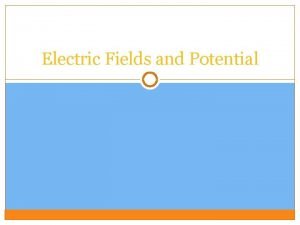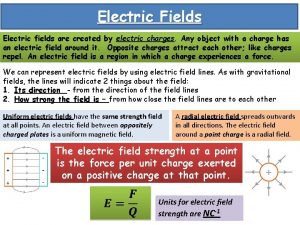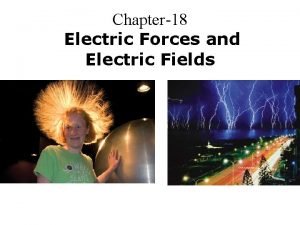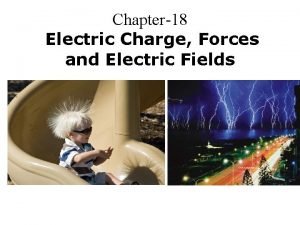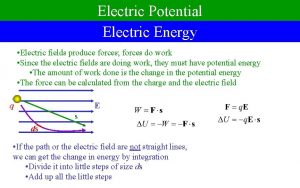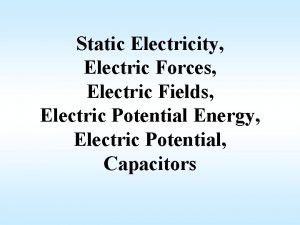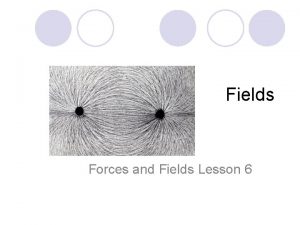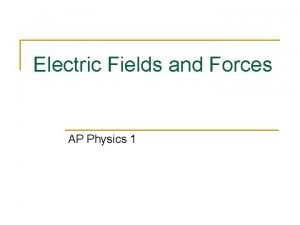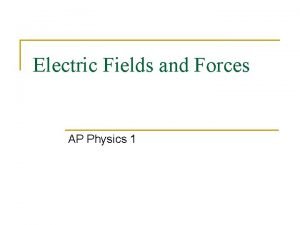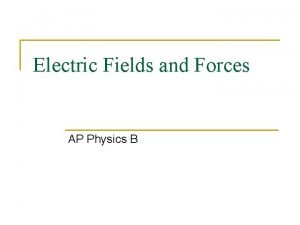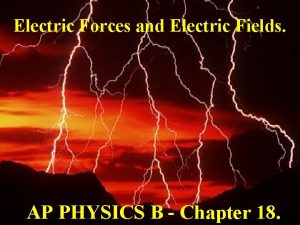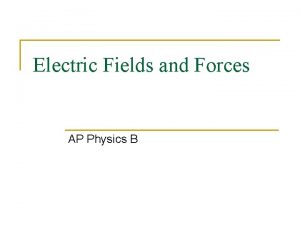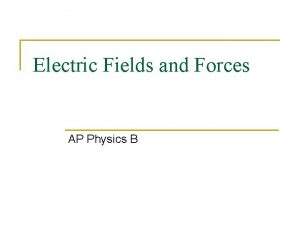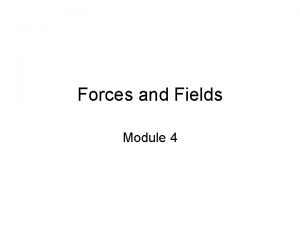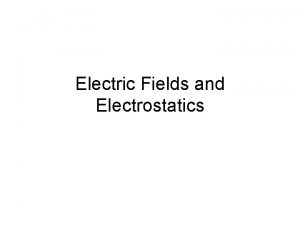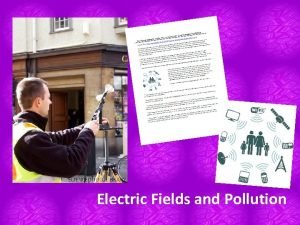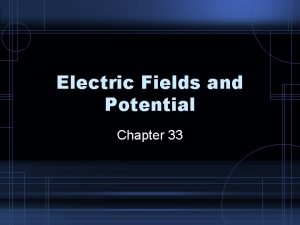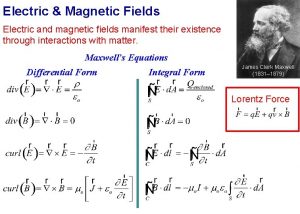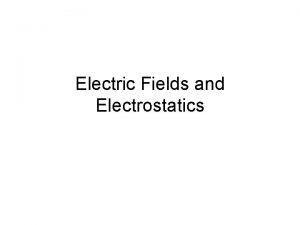Electric Fields and Forces AP Physics C Electric
































- Slides: 32

Electric Fields and Forces AP Physics C

Electric Charge “Charge” is a property of subatomic particles. Facts about charge: n There are basically 2 types: positive (protons) and negative (electrons) n LIKE charges REPEL and OPPOSITE charges ATTRACT n Charges are symbolic of fluids in that they can be in 2 states, STATIC or DYNAMIC.

Electric Charge – The specifics • The symbol for CHARGE is “q” • The unit is the COULOMB(C), named after Charles Coulomb • If we are talking about a SINGLE charged particle such as 1 electron or 1 proton we are referring to an ELEMENTARY charge and often use, e , to symbolize this. Some important constants: Particle Charge Mass Proton 1. 6 x 10 -19 C 1. 67 x 10 -27 kg Electron 1. 6 x 10 -19 C 9. 11 x 10 -31 kg Neutron 0 1. 67 x 10 -27 kg

Charge is “CONSERVED” Charge cannot be created or destroyed only transferred from one object to another. Even though these 2 charges attract initially, they repel after touching. Notice the NET charge stays the same.

Conductors and Insulators The movement of charge is limited by the substance the charge is trying to pass through. There are generally 2 types of substances. Conductors: Allow charge to move readily though it. Insulators: Restrict the movement of the charge Conductor = Copper Wire Insulator = Plastic sheath

Charging and Discharging There are basically 2 ways you can charge “BIONIC is the first-ever ionic formula something. mascara. The primary ingredient in 1. Charge by friction BIONIC is a chain molecule with a positive charge. The friction caused by sweeping the mascara brush across 2. Induction lashes causes a negative charge. Since opposites attract, the positively charged formula adheres to the negatively charged lashes for a dramatic effect that lasts all day. ”

Induction and Grounding The second way to charge something is via INDUCTION, which requires NO PHYSICAL CONTACT. We bring a negatively charged rod near a neutral sphere. The protons in the sphere localize near the rod, while the electrons are repelled to the other side of the sphere. A wire can then be brought in contact with the negative side and allowed to touch the GROUND. The electrons will always move towards a more massive objects to increase separation from other electrons, leaving a NET positive sphere behind.

Electric Force The electric force between 2 objects is symbolic of the gravitational force between 2 objects. RECALL:

Electric Forces and Newton’s Electric Forces and Fields obey Newton’s Laws Example: An electron is released above the surface of the Earth. A second electron directly below it exerts an electrostatic force on the first electron just great enough to cancel out the gravitational force on it. How far below the first electron is the second? Fe e mg e r=? 5. 1 m

Electric Forces and Vectors Electric Fields and Forces are ALL vectors, thus all rules applying to vectors must be followed. Consider three point charges, q 1 = 6. 00 x 10 -9 C (located at the origin), q 3 = 5. 00 x 10 -9 C, and q 2 = -2. 00 x 10 -9 C, located at the corners of a RIGHT triangle. q 2 is located at y= 3 m while q 3 is located 4 m to the right of q 2. Find the resultant force on q 3. Which way does q 2 push q 3? 4 m q 2 q 3 Which way does q 1 push q 3? 3 m q 1 q Fon 3 due to 1 5 m Fon 3 due to 2 q= tan-1(3/4) q 3 q = 37

Example Cont’ 4 m q 2 3 m q 1 q q 3 Fon 3 due to 1 5 m q= tan-1(3/4) Fon 3 due to 2 q 3 q = 37 F 3, 1 sin 37 F 3, 1 cos 37 5. 6 x 10 -9 N 7. 34 x 10 -9 N 1. 1 x 10 -8 N 64. 3 degrees above the +x

Coulomb’s Law is used to find the MAGNITUDE only! In Figure A, we see that "i" is added to justify a direction on the x-axis. In figure B, we see that "j" is added to justify a direction on the +Y-axis. In figure C, we see a way to express the force in terms of polar notation! The angle is actually, measured counter clockwise from the horizontal.

Example Two weights of mass m = 0. 25 kg are attached to separate strings of length L = 0. 4 m and hung from a common point on the ceiling. When a charge "q" is placed on each mass, the masses repulse and swing out away from one another forming an angle of 22 degrees. What is the charge q? 0. 076 m 0. 153 m 11 r T 11 L=0. 4 m FE mg 1. 11 x 10 -6 C or 1. 11 m. C

Electric Fields By definition, the are “LINES OF FORCE” Some important facts: n An electric field is a vector n Always is in the direction that a POSITIVE “test” charge would move n The amount of force PER “test” charge If you placed a 2 nd positive charge (test charge), near the positive charge shown above, it would move AWAY. If you placed that same charge near the negative charge shown above it would move TOWARDS.

Electric Fields and Newton’s Once again, the equation for Laws ELECTRIC FIELD is symbolic of the equation for WEIGHT just like coulomb’s law is symbolic of Newton’s Law of Gravitation. The symbol for Electric Field is, “E”. And since it is defined as a force per unit charge he unit is Newtons per Coulomb, N/C. NOTE: the equations above will ONLY help you determine the MAGNITUDE of the field or force. Conceptual understanding will help you determine the direction. The “q” in the equation is that of a “test charge”.

Example An electron and proton are each placed at rest in an external field of 520 N/C. Calculate the speed of each particle after 48 ns What do we know me=9. 11 x 10 -31 kg 8. 32 x 10 -17 N mp= 1. 67 x 10 -27 kg qboth=1. 6 x 10 -19 9. 13 x 1013 m/s/s C 4. 98 x 1010 m/s/s vo = 0 m/s E = 520 N/C 4. 38 x 106 m/s t = 48 x 10 -9 s 2. 39 x 103 m/s

An Electric Point Charge As we have discussed, all charges exert forces on other charges due to a field around them. Suppose we want to know how strong the field is at a specific point in space near this charge the calculate the effects this charge will have on other charges should they be placed at that point. Likewise for a very small amount of charge. TEST CHARGE POINT CHARGE

Example A -4 x 10 -12 C charge Q is placed at the origin. What is the magnitude and direction of the electric field produced by Q if a test charge were placed at x = -0. 2 m ? 0. 2 m 0. 899 N/C E Towards Q to the right E -Q E Remember, our equations will only give us MAGNITUDE. And the electric field LEAVES POSITIVE and ENTERS NEGATIVE. E

Electric Field of a Conductor A few more things about electric fields, suppose you bring a conductor NEAR a charged object. The side closest to which ever charge will be INDUCED the opposite charge. However, the charge will ONLY exist on the surface. There will never be an electric field inside a conductor. Insulators, however, can store the charge inside. There must be a positive charge on this side There must be a negative charge on this side OR this side was induced positive due to the other side being negative.

Extended Charge Distributions All we have done so far has been dealing with specific POINTS in space. What if we are dealing with an OBJECT that has a continuous amount of charge over its surface? Consider a hoop of radius R with a total charge of Q distributed uniformly on its surface. Let's derive an expression for the electric field at distance “b” units down the +x axis. We begin by defining a differential charge dq at some arbitrary position on the loop. This differential amount of charge will produce a differential electric field d. E at x=b

Extended Charge Distributions We begin by defining a differential charge dq at some arbitrary position on the loop. This differential amount of charge will produce a differential r electric field d. E at x=b q d. Ecosq q d. Esinq d. E What is r, the separation distance from the dq to point b?

Extended Charge Distributions What is r, the separation distance from the dq to point b? R r q r d. Ecosq q d. E b d. Esinq

Extended Charge Distributions r q d. Ecosq q d. Esinq d. E That is for ONE very small amount of charge! To find the TOTAL E-field for each an every little dq, we would need to? ? ? INTEGRATE!

Extended Charge Distributions How do we know we did it right? Let’s make b >>>> R, then R would be so tiny that from that distance the hoop would look like a point. So if R went to ZERO, then the expression would look like: It is the SAME equation as that of a point charge!

Extended Charge Distributions Assume that for an “insulating” disk the charge is distributed throughout its area. We must use the SAME technique to derive the moments of inertia. Except, instead of the mass being distributed, it is the CHARGE.

Extended Charge Distributions We still need to apply the limits!

Extended Charge Distributions Let’s make R >>>>> b, in other words we are looking at the disk UP CLOSE. Thus b approaches ZERO and R would go to infinity. What happens? What does this mean? The electric field, when distributed over an area is INDEPENDENT of separation distance. This means that the field is CONSTANT at all points away from the area.

Your turn (let’s take it step by What is the electric field, E, as a function of r. for an step) INFINITE LINE of charge (a. k. a “a very long rod”). Begin with the horizontal! y + + + r x What is dq equal to?

Your turn (let’s take it step by What is the electric field, E, as a function of r. for a LINE step) of charge (a. k. a “a rod”). Begin with the horizontal! y + + + r x What is d. Ex equal to?

Your turn (let’s take it step by What is the electric field, E, as a function of r. for a LINE step) of charge (a. k. a “a rod”). Begin with the horizontal! y + + + r What is Ex equal to? x By making x = r, we are saying this is the electric field along a line parallel to the rod a distance, x, or r in this case , away.

What about the “y” direction? The equation is identical except for HOW you solve the integration. In the horizontal we could bring the “x” out because it was constant. In this case, the “y” CANNOT be brought out as the dq varies in height above and below the origin. So the “y” is a CHANGING variable. ZERO! The “y” components CANCEL out above an below the rod. The ones below the origin extend upward and the ones above the rod extend downwards. The symmetry CAUSES the components to cancel out.

In summary All of the electric charge distributions were derived from that of a point charge. Distributions can produce different functions depending on whether the charge is distributed over a LENGTH, AREA, or VOLUME. Function Point, hoop, or Sphere (Volume) Disk or Sheet (AREA) Line, rod, or cylinder (LINEAR) Equation These equations are important for later so keep these in mind!
 Electric forces and fields concept review
Electric forces and fields concept review Chapter 16: electric forces and fields answers
Chapter 16: electric forces and fields answers Red fields to green fields
Red fields to green fields Electric charges and electric forces lesson outline
Electric charges and electric forces lesson outline Learning: module 26: magnetic forces and fields
Learning: module 26: magnetic forces and fields Chapter 33 conceptual physics
Chapter 33 conceptual physics Electric currents and magnetic fields
Electric currents and magnetic fields Visualizing magnetic field
Visualizing magnetic field Electric fields quiz
Electric fields quiz Electric fields
Electric fields Electric fields
Electric fields Induced electric field
Induced electric field Physics chapter 21 study guide answers
Physics chapter 21 study guide answers Electric field for a disk
Electric field for a disk 5 examples of like parallel forces
5 examples of like parallel forces What are some contact forces and some noncontact forces
What are some contact forces and some noncontact forces Net force
Net force Erosion is a destructive force that
Erosion is a destructive force that Edexcel igcse physics forces and motion questions
Edexcel igcse physics forces and motion questions Physics 03-02 potential energy and conservative forces
Physics 03-02 potential energy and conservative forces Terminal velocity igcse
Terminal velocity igcse The forces shown above are
The forces shown above are Intermolecular vs intramolecular forces
Intermolecular vs intramolecular forces Similarities of intermolecular and intramolecular forces
Similarities of intermolecular and intramolecular forces Intermolecular force of attraction
Intermolecular force of attraction Electric field
Electric field Electric field electric potential
Electric field electric potential Electric potential and electric field
Electric potential and electric field Chapter 21 electric charge and electric field
Chapter 21 electric charge and electric field Chapter 21 electric charge and electric field
Chapter 21 electric charge and electric field Units for coulombs
Units for coulombs Dc o/d per item charge
Dc o/d per item charge Anticlockwise moment definition
Anticlockwise moment definition








